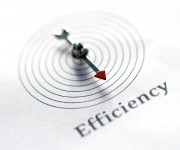Senate majority leader Harry Reid is pulling together an energy bill soon. It may or may not include a price on carbon, but it will certainly include a range of energy-focused provisions, and right now there are too few bold, progressive energy ideas on the table.
As I said yesterday, Sen. Jeff Merkley’s oil plan is a good step toward expanding the range of options, but more is needed: “What I’d really like to see are similar bills focused on saving electricity (with a tough EERS) and building out renewable energy (with a tough RES).”
Well, it looks like Sen. Merkley is reading Grist and has put something together for me. *cough*
At a press conference this morning, Merkley will introduce a new report on the part energy efficiency can play in energy legislation. The research, by the American Council for an Energy-Efficient Economy, analyzes the economic and job effects of the Senate climate and energy bills and how those effects could be boosted with additional efficiency provisions.
Their key finding: “by enhancing the energy efficiency provisions in the legislation, the number of jobs created could nearly triple, energy savings could quadruple, and consumer savings could increase by about $200 per household per year.” Here are those benefits compared to baseline:
Year 2030 Impacts of Climate and Energy Legislation Relative to Business as Usual
Job Gains Annual Consumer Savings
(Per Household)APA + ACELA 166,000 $256 Moderately Enhanced Energy Efficiency Policy 364,000 $448 Major Expansion of Energy Efficiency 689,000 $673
Here are the benefits in energy savings (in 2020) relative to other legislation:
 Source: ACEEE
Source: ACEEE
As I’ve said a million times (and counting), energy efficiency is the obvious starting point for energy legislation. It serves virtually every goal of energy policy simultaneously, at negative cost. If you approach the public with a plan that will save every one of them money, create hundreds of thousands of jobs, and reduce greenhouse gas emissions … well, that’s a different conversation than the one around an “energy tax.”
As Merkley has noted, lots of folks on the left are ready to take their toys and go home, abandoning hope for progress on energy this year. But this is a narrow window of opportunity. However bad the political playing field looks, it’s going to get worse soon and stay worse for a good while. Even if the long-pursued carbon price doesn’t come to fruition, it’s still in progressives’ interest to get noisy around the strongest energy efficiency provisions possible.
At the very least somebody needs to get them on Harry Reid’s desk. He can’t build anything of worth without good raw materials.
——
Nerd addendum:
Here’s where the additional savings come from:
 Source: ACEEE
Source: ACEEE
Here’s how many more jobs will be created:
 Source: ACEEE
Source: ACEEE
Here’s how much more money consumers will save:
 Source: ACEEE
Source: ACEEE
Here are the report’s policy recommendations:
- Complement the APA with energy legislation, including a robust 10% EERS: A strong energy efficiency resource standard empowers utilities, consumers and businesses to reap the financial benefits of energy efficiency and lower the cost of reducing emissions.
- Require electric utilities to spend 20% of their free emissions allowances on energy efficiency, and natural gas utilities to spend 33% on energy efficiency: Utilities are given emissions allowances for “consumer benefit.” A portion of these funds should be invested in efficiency, which will offer long term benefits to consumers including reduced energy bills.
- Continue state energy efficiency programs in APA past 2015 or 2021: The limited number of energy-efficiency programs in APA phase out, some in 2015, others in 2021. These should be extended until 2030 at a minimum, and this allocation should be increased to 6% of emissions allowances, in line with the average in the House-passed energy and climate bill.
- Expand support for industrial energy efficiency provisions: Direct industrial allocations to support manufacturing R&D and investments in new manufacturing capacity to improve efficiency and build the clean energy economy, thereby creating thousands of American jobs.
- Enhance provisions to improve transportation efficiency: Better target transportation investments to ensure they achieve greenhouse gas reductions and improve the efficiency of the transportation system.
- Strengthen conditions for the Clean Vehicle Technology Fund: Include only vehicles that exceed federal fuel economy standards by 25%.



